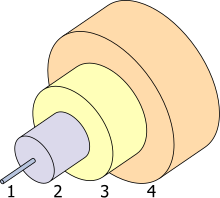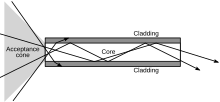Core (optical fiber): Difference between revisions
ClueBot NG (talk | contribs) m Reverting possible vandalism by 193.33.246.241 to older version. False positive? Report it. Thanks, ClueBot NG. (1458908) (Bot) |
No edit summary |
||
| Line 9: | Line 9: | ||
The '''core''' of a conventional [[optical fiber]] is a cylinder of [[glass]] or [[plastic]] that runs along the fiber's length. The core is surrounded by a medium with a lower [[index of refraction]], typically a [[Cladding (fiber optics)|cladding]] of a different glass, or plastic. Light travelling in the core reflects from the core-cladding boundary due to [[total internal reflection]], as long as the angle between the light and the boundary is less than the [[critical angle]]. As a result, the fiber transmits all [[ray (optics)|ray]]s that enter the fiber with a sufficiently small angle to the fiber's axis. The limiting angle is called the [[Guided ray|acceptance angle]], and the rays that are confined by the core/cladding boundary are called [[guided ray]]s. |
The '''core''' of a conventional [[optical fiber]] is a cylinder of [[glass]] or [[plastic]] that runs along the fiber's length. The core is surrounded by a medium with a lower [[index of refraction]], typically a [[Cladding (fiber optics)|cladding]] of a different glass, or plastic. Light travelling in the core reflects from the core-cladding boundary due to [[total internal reflection]], as long as the angle between the light and the boundary is less than the [[critical angle]]. As a result, the fiber transmits all [[ray (optics)|ray]]s that enter the fiber with a sufficiently small angle to the fiber's axis. The limiting angle is called the [[Guided ray|acceptance angle]], and the rays that are confined by the core/cladding boundary are called [[guided ray]]s. |
||
The core is balls and asses |
|||
characterized by its [[diameter]] or [[Cross section (geometry)|cross-sectional]] area. In most cases the core's cross-section should be circular, but the diameter is more rigorously defined as the average of the diameters of the smallest circle that can be circumscribed about the core-cladding boundary, and the largest circle that can be inscribed within the core-cladding boundary. This allows for deviations from circularity due to manufacturing variation. |
|||
Another commonly-quoted statistic for core size is the [[mode field diameter]]. This is the diameter at which the [[intensity (physics)|intensity]] of light in the fiber falls to some specified fraction of maximum (usually 1/e<sup>2</sup>≈13.5%). For single-mode fiber, the mode field diameter is larger than the physical diameter of the core, because the light penetrates slightly into the cladding as an [[evanescent wave]]. |
Another commonly-quoted statistic for core size is the [[mode field diameter]]. This is the diameter at which the [[intensity (physics)|intensity]] of light in the fiber falls to some specified fraction of maximum (usually 1/e<sup>2</sup>≈13.5%). For single-mode fiber, the mode field diameter is larger than the physical diameter of the core, because the light penetrates slightly into the cladding as an [[evanescent wave]]. |
||
Revision as of 13:18, 22 January 2013

1. Core 8 µm diameter
2. Cladding 125 µm dia.
3. Buffer 250 µm dia.
4. Jacket 400 µm dia.

The core of a conventional optical fiber is a cylinder of glass or plastic that runs along the fiber's length. The core is surrounded by a medium with a lower index of refraction, typically a cladding of a different glass, or plastic. Light travelling in the core reflects from the core-cladding boundary due to total internal reflection, as long as the angle between the light and the boundary is less than the critical angle. As a result, the fiber transmits all rays that enter the fiber with a sufficiently small angle to the fiber's axis. The limiting angle is called the acceptance angle, and the rays that are confined by the core/cladding boundary are called guided rays.
The core is balls and asses
characterized by its diameter or cross-sectional area. In most cases the core's cross-section should be circular, but the diameter is more rigorously defined as the average of the diameters of the smallest circle that can be circumscribed about the core-cladding boundary, and the largest circle that can be inscribed within the core-cladding boundary. This allows for deviations from circularity due to manufacturing variation.
Another commonly-quoted statistic for core size is the mode field diameter. This is the diameter at which the intensity of light in the fiber falls to some specified fraction of maximum (usually 1/e2≈13.5%). For single-mode fiber, the mode field diameter is larger than the physical diameter of the core, because the light penetrates slightly into the cladding as an evanescent wave.
